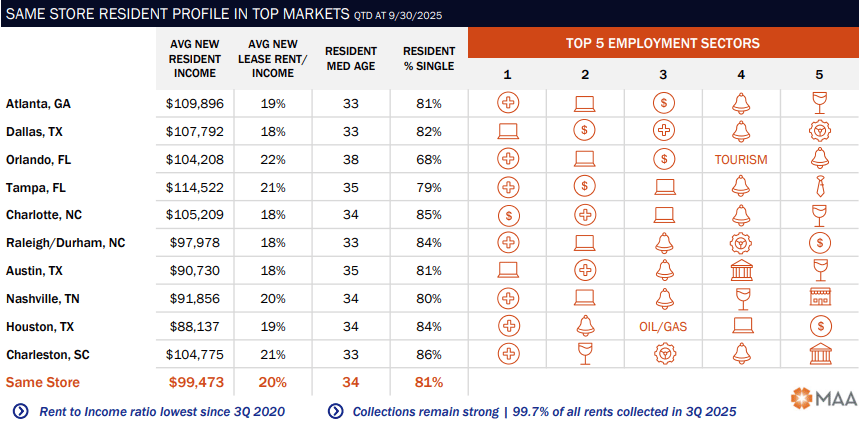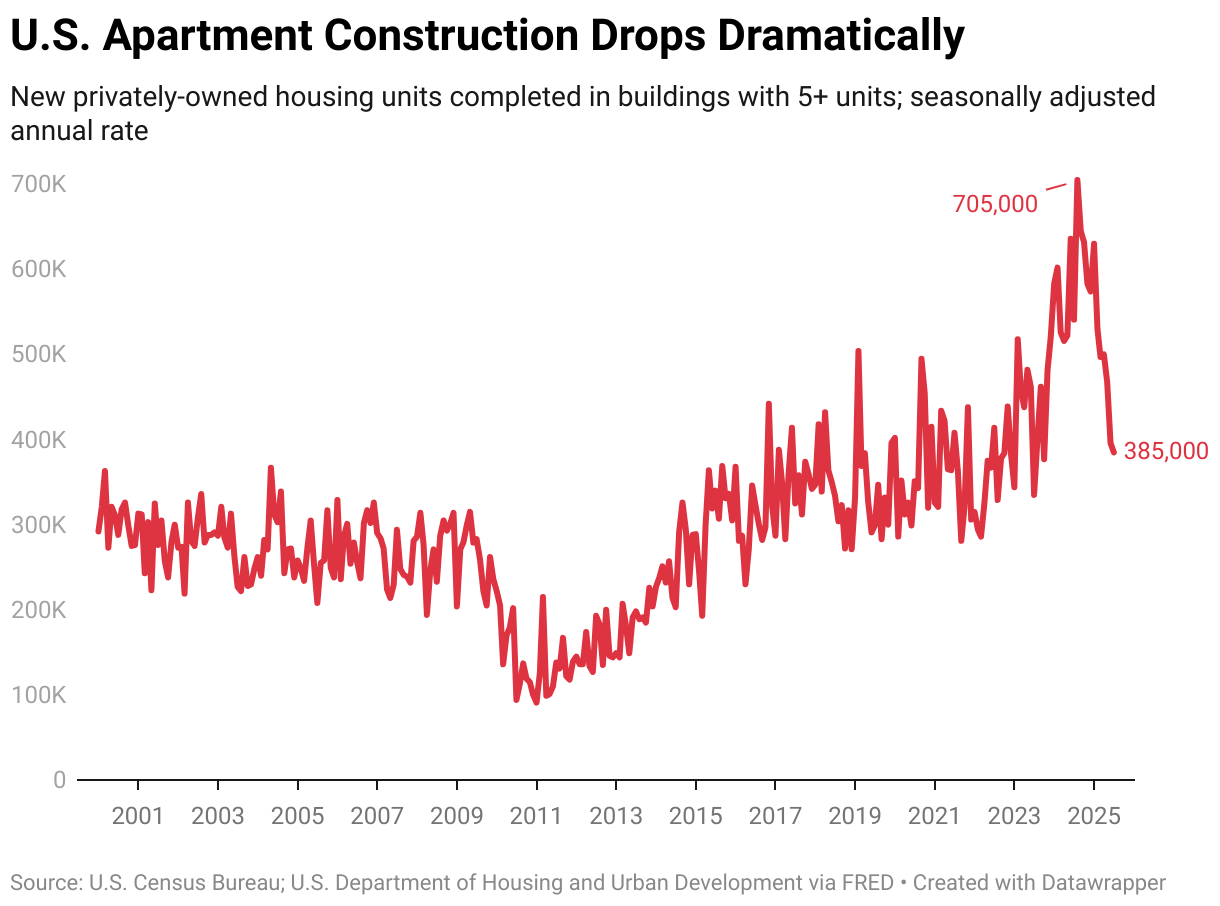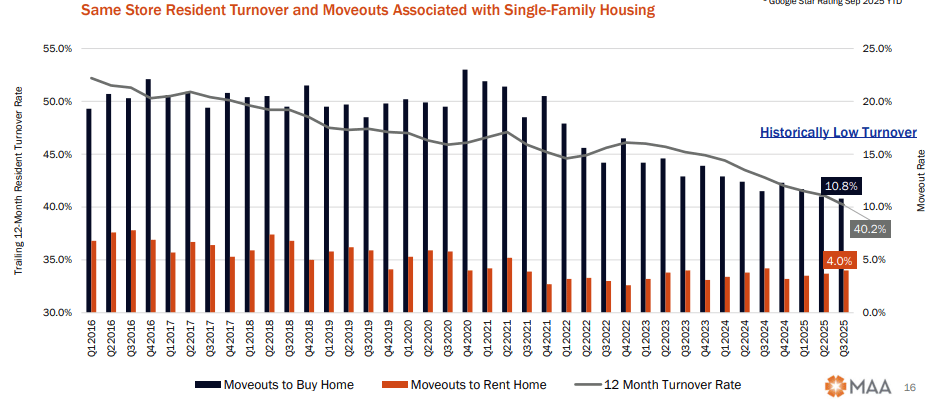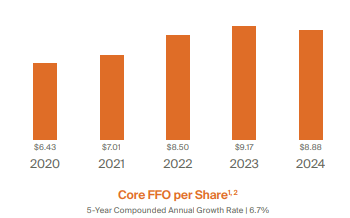- Canadian Dividend Investing
- Posts
- Mid-America Apartment REIT: Stock and Dividend Analysis
Mid-America Apartment REIT: Stock and Dividend Analysis
Is this beaten up U.S. REIT an income opportunity for Canadian investors?
This is a sample of in-depth individual company research we offer premium members each week. To see more about what we offer on the premium side of the newsletter, click here.
The beauty of REITs is they give an investor real estate exposure without having to make any repairs, do any showings, or chase down any bad debts.
They’re the lazy man’s version of real estate, and that’s exactly what I’m looking for.
Yes, you can make more money investing in physical real estate if you’re an astute investor who can sniff out the best opportunities. I know a few of these guys, and some of the deals they’ve gotten over the years are astounding.
I know someone who is collecting a ~50% cap rate on a property purchased in the mid-1990s. The house had issues, and he used his experience to realize the repair was actually quite simple. He did the repair, fixed up a few other things, and the rest is history.
The problem for you and me is two-fold. Firstly, these opportunities don’t come up for us. The professionals gobble them up quickly. And secondly, we don’t have the experience to pick these hidden gems amid all the properties with unfixable problems.
And so we’re stuck with passive options.
The good news for us REIT investors is every now and again the public market gives us good deals on large portfolios of properties. Not 50% cap rate deals, but deals that are good enough to deliver nice returns.
Today on the newsletter I want to highlight one REIT that I think is a quite good value today, Mid-America Properties (NYSE:MAA). Let’s take a closer look.

The skinny
Mid-America Apartments is the owner of nearly 105,000 apartments in the United States. Its portfolio spans most of the southern half of the United States, stretching as far north as Salt Lake City, Denver, and Kansas City. Much of the portfolio is located in the Sunbelt, which offers a few advantages we’ll discuss in a little bit.

The portfolio is concentrated in and around major regional centres, with the ten largest markets contributing approximately 65% of total net operating income (NOI). It does have some assets in mid-tier markets, but that’s only a smaller part of the portfolio. Besides, these secondary markets are still cities with 100,000 to 250,000 people. They’re hardly small towns.
Occupancy has remained steady in the 95-96% range for a few years now.

These Sunbelt cities offer a few advantages versus other parts of the country. Firstly, they’re growing; Americans are increasingly moving to places like Georgia, Texas, Florida, and North Carolina. Folks are attracted to these markets because of economic opportunity, lower state taxes (especially if they come from California), the weather, and because a lot of other young people are moving to these places.
These markets tend to be fairly landlord friendly, too. There’s no rent control and many have no limits to how quickly landlords can increase rents.
But what they’re really coming for is the affordability. In Mid-America’s ten-largest markets, its average rent-to-income ratio is just 20%. If you don’t pay a lot for real estate it’s a lot easier to get ahead, and I couldn’t be happier that millions of Americans have realized this. This phenomenon is a big reason why I continue to stay in Alberta; the value is just too good here. I can get a really nice house here for the price of a small condo in Downtown Toronto.

Another advantage to affordable units is rental increases are much easier to push through. If your rent is 20% of your income and it goes up 5%, then it’s only 21% of your income. This, combined with other growth initiatives that we’ll discuss below, help apartment REITs increase their earnings over time.
At least it does until it stops.
Your author used to own physical properties before they were sold and replaced with REITs for my real estate exposure. I owned residential properties because, as they say, everybody needs a place to live. I viewed them as non-cyclical assets.
But it turns out I was wrong in this assessment. Residential real estate is much more cyclical than you’d think — because developers are constantly at work putting up new properties. These developers often go nuts when times are good or if interest rates are low, which leads to some oversupply.
This is exactly what has happened over the last few years, which has created a bit of a glut in Mid America’s primary markets. These properties have been coming online and pushing rents lower. AMRs (average monthly rents) have been dropping over the last year in places like Atlanta (down 1.3%), Austin (down 2%), Denver (down 5.2%), Orlando (down 3.5%), and Phoenix (down 1.6%).
We’ll note that these numbers were current as of the end of June. Current numbers are starting to move in a more happy direction, but I want to present the more bearish scenario here. Because that’s what the market believes right now.
On the plus side, apartment development is falling off a cliff. The number of new units hitting the market hit a seasonally adjusted annual rate of 385,000 in July, down significantly from 2024’s highs.

This is a backwards looking measure. To get the big picture we also have to look at apartment starts. Mid-America has done the work here, and it’s good news. Developers have slowed their activity in Mid-America’s markets significantly. This should bode well for 2027 and 2028, but these days the average investor doesn’t look out that far.

Mid-America is also doing a nice job retaining more tenants. Turnover rate has fallen from more than 50% in 2021 to right around 40% today. We’ll note that a lot of MAA’s tenants move out to purchase homes, so a slower real estate market actually helps them with retention. Ultimately, higher retention = more profits.

Next, allow me to profile MAA’s balance sheet — which is actually a large reason why I was interested in the stock in the first place. The REIT has a debt-to-capitalization ratio of just 24%, and virtually all of the debt is secured against the company itself, rather than the properties. This creates some flexibility when it’s time to refinance debt.

The REIT’s debt-to-assets ratio isn’t quite as good, but it’s still attractive. You’re looking at a debt-to-assets ratio of 29.3%, which the equivalent of owing $58,600 against a $200,000 property. That’s a nice margin of safety.
Such a low debt-to-assets ratio is attractive for a few different reasons. Firstly, you know that this collection of real estate assets that you’re buying isn’t in danger of going bankrupt anytime soon. Such a strong balance sheet also lowers the cost of interest. It also opens up both acquisition and development opportunities, both of which can be easily financed by a combination of existing cash flow and new debt. A lot of REITs have to perpetually issue equity to expand. Mid-America doesn’t have that problem.
Intermission
More Nelly for your eyeballs and earholes? You got it.
This week on the DIY Wealth Canada Podcast, Bob and I explore the world of ETFs and focus on one problem — there’s just too damned many of them. How is a regular investor supposed to sift through all the noise and come up with an easy strategy that actually works?
We have some ideas.
You can listen to it on Spotify, or wherever else you get your podcasts. Make sure you give us a subscribe so you never miss another episode, either!
You can also watch it on YouTube below:
The opportunity
Now that we’re familiar with the apartment business, let’s see whether Mid-America is an attractive buy today.
Let’s first take a closer look at earnings, which for a REIT are measured in funds from operations. Mid-America has already warned investors that results will be a little soft this year, with rent growth turning ever so slightly negative.
FFO is expected to be $8.74 per unit this year, with a range of $8.68 to $8.80 being possible. Considering how most of 2025 is now over, I’ve got pretty good confidence in these numbers.

The problem is that number is lower than previous years. In 2023 the company earned $9.17 per unit in FFO. 2024’s numbers weren’t quite as good, but core FFO still came in at $8.88 per unit.
These numbers are still significantly higher than 2020 and 2021 numbers, but investors don’t really care about that. It’s all about what the company has done for them lately — and the answer to that is it hasn’t grown. That’s bad.

Let’s look at things in a slightly different way. Here’s a stock chart for the last five years. We’ll notice that the stock has basically did nothing since the latter part of 2020. Shares are pretty much flat.

Meanwhile, earnings will have increased from $6.23 per unit in 2020 to somewhere around $8.75 per unit in 2025. That’s growth of about 36% in five years — which isn’t bad considering the issues the company is dealing with today.
The company also has a long-term record of growing about 6-7% per year, driven by a combination of rent increases, acquiring properties, developing others, and spending cash fixing up units. These newly renovated apartments then command higher rents.
And unlike other types of real estate, some 40% of units turn over each year. When rents are increasing this is a good thing, since the property can generally be re-rented at a higher price.
Investors who buy today are getting 36% more earnings per dollar paid than they got five years ago. That suggests to me that the stock is cheap.
Another metric I’ll use to argue the stock is undervalued is the dividend yield. I believe in buying as much dividend income as possible when I purchase a stock, a practice that doesn’t mean I default to the highest yield available. What that means is I’m looking for a dividend yield that’s close to a multi-year high — as well as a reasonable payout ratio.
In short, I’m looking for good companies, and then I want to buy them at a time when I can maximize my dividend income.
MAA checks off this box. The current yield is 4.7%, and that’s flirting with a 10-year high.

Finally, shares are trading at approximately 15x FFO — a valuation I think is fair considering the quality of the overall portfolio, potential long-term growth, and the conservative balance sheet.
Further reading: Here’s a list of what I’m looking for when I invest in REITs.
Dividend analysis
We normally analyze buybacks in this section as well, but Mid-America — like a lot of REITs — doesn’t offer much here. But, on the plus side, it hasn’t really been a big issuer of shares either. That’s good news.
Mid-America has an excellent record of providing shareholders with steady income. It first started paying investors back in 1994, and it isn’t missed or cut its dividend in its more than 30 year history as a publicly-traded REIT. That’s an excellent start.
Although it doesn’t have the kind of dividend growth streak that many are looking for, MAA has a history of fairly consistent dividend hikes. After temporarily pausing dividend growth after the 2008-09 financial crisis, MAA resumed dividend growth in 2011 and hasn’t looked back since.

These days the payout is $6.06 per share, which works out to a payout ratio of approximately 70% of FFO. This is a fine payout ratio when you compare it to most other REITs, but it’s actually a little high compared to some of MAA’s peers. For instance, Essex Property Trust (NYSE:ESS) has a payout ratio of about 65%, although its yield is only a hair over 4%. Camden Property Trust (NYSE:CPT) has similar metrics. You’re getting a slightly higher yield in exchange for the slightly higher payout ratio, which is a trade I think most of you would be happy making.
Anyway, the payout ratio should be fine, and the dividend should continue to grow over time. 70% is a very reasonable payout ratio for a REIT.
Dividend safety: High
Dividend growth potential: 3-6% annually
Worried about how the payout will be taxed? Read this. It’ll help.
The bottom line
Let’s summarize both the bull and bear arguments for Mid-America Apartment REIT. Starting with the bull side, we have:
Long-term growth potential in the Sunbelt area
A great balance sheet
History of dividend growth
An attractive yield today, especially when compared to the company’s history
Turnover rate is slowing
Three growth prongs — including increasing rents, acquiring/developing new properties, and fixing up existing units
It largely owns apartments in affordable markets
Reasonable valuation
And on the bear side, we have
Uncertainty about rents in 2026-27, could easily fall
Macro concerns about interest rates
In short, this is the kind of situation we really like around here. This is a company with temporary problems that it has worked through before. It owns a bunch of good assets with only a minimal amount of debt encumbered on them. Shares are so cheap that they’re flat in the last five years, despite earnings increasing during that time.
Plus, you’re getting an almost 5% yield to wait, which is an excellent payout based on both the apartment REIT sector and this company’s history. MAA’s yield hasn’t been this high in a decade, and the payout comes with a reasonable 70% payout ratio. Not only do I think it’s sustainable, but I think it marches higher over time.
I’m a fan. This is pretty much exactly the situation that dividend growth investors should be looking for.
Nothing written above is investment advice. It is for research and educational purposes only. Consult a qualified financial advisor before making any investment decisions. Author’s portfolio positions are disclosed to premium subscribers only.